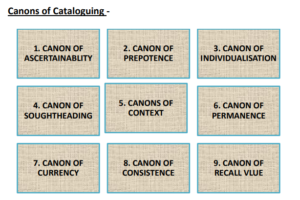Canons propounded by Dr. S.R. Ranganathan
CANON OF CATALOGUING
INTRODUCTION –
- In the context of cataloguing normative principles are those rules, laws, canons and principles which govern the preparation of catalogue codes and various types of entries, choice of headings, rendering of headings, description and other things related with the cataloguing of documents. S.R. Ranganathan has used 3 terms to denote his normative principles viz: Law, Canon and Principle.
- Law is the correct statement and is used in major disciplines such as Laws of Library Science, Newton‟s Law etc. Law tells us what we have to do and what not to do.
Canon means a general principle or standard by which judgements may be formed , Ranganathan has used the term in the context of divisions of first order of the major discipline such as cataloguing, classification, book selection etc. - Principle is a rule regulating the procedure or method necessary to be observed in the pursuit or study of some art or science. Ranganathan has used this term in the context of divisions of the second or later order of the major disciplines such as Principle of Facet Sequence in Classification and Principle of Alphabetization in Cataloguing.
USE OF CANON OF CATALOGUING –
As the light house guide the ships in the night on the sea, these canons and principles guide the cataloguers in their day to day work of cataloguing to achieve uniformity, consistency and accuracy.
Canons of cataloguing are the specific normative principles applicable to cataloguing, that is:
1. Drafting of a catalogue code including the formulation of each rule.
2. Interpretation of the rules to meet new situations brought out by a particular document or by
changes in the practice of book production.
3. Provision of suitable guidance for day to day cataloguing work.
4. To make critical study of any catalogue code.
Canons of Cataloguing –

More about Canons of Cataloguing: